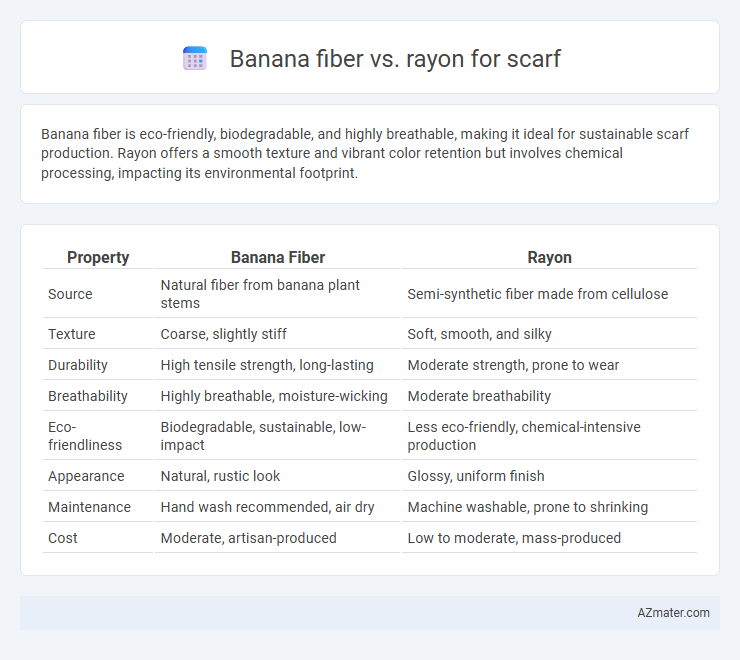Banana fiber is eco-friendly, biodegradable, and highly breathable, making it ideal for sustainable scarf production. Rayon offers a smooth texture and vibrant color retention but involves chemical processing, impacting its environmental footprint.
Table of Comparison
| Property | Banana Fiber | Rayon |
|---|---|---|
| Source | Natural fiber from banana plant stems | Semi-synthetic fiber made from cellulose |
| Texture | Coarse, slightly stiff | Soft, smooth, and silky |
| Durability | High tensile strength, long-lasting | Moderate strength, prone to wear |
| Breathability | Highly breathable, moisture-wicking | Moderate breathability |
| Eco-friendliness | Biodegradable, sustainable, low-impact | Less eco-friendly, chemical-intensive production |
| Appearance | Natural, rustic look | Glossy, uniform finish |
| Maintenance | Hand wash recommended, air dry | Machine washable, prone to shrinking |
| Cost | Moderate, artisan-produced | Low to moderate, mass-produced |
Introduction: The Rise of Sustainable Scarves
Banana fiber, derived from the pseudostems of banana plants, offers a naturally biodegradable and eco-friendly alternative to conventional rayon, which is chemically processed from cellulose. This sustainable fiber boasts high tensile strength, breathability, and a unique texture, making it ideal for eco-conscious scarf production. Demand for banana fiber scarves is growing rapidly as consumers seek sustainable fashion options that combine environmental responsibility with aesthetic appeal.
What is Banana Fiber?
Banana fiber is a natural textile fiber extracted from the pseudostems of banana plants, known for its strength, durability, and eco-friendly qualities. Unlike rayon, which is a semi-synthetic fiber made from processed cellulose, banana fiber retains its organic origins and requires minimal chemical treatment during production. This sustainable fiber boasts excellent breathability and moisture-wicking properties, making it an ideal choice for lightweight, comfortable scarves.
Understanding Rayon: Origins and Production
Rayon is a semi-synthetic fiber derived from cellulose extracted from wood pulp, primarily sourced from hardwood trees like beech, pine, and eucalyptus. The production process involves chemically treating the cellulose with sodium hydroxide and carbon disulfide to create viscose, which is then spun into fibers. This method allows rayon to mimic natural fibers such as silk, cotton, and wool, making it a versatile choice for scarves with a smooth texture and excellent drape.
Environmental Impact: Banana Fiber vs Rayon
Banana fiber is a sustainable material derived from agricultural waste, requiring minimal chemical processing and producing low carbon emissions, making it an eco-friendly choice for scarves. Rayon, a semi-synthetic fiber made from chemically treated wood pulp, involves intensive water and chemical use, contributing to deforestation and pollution. Choosing banana fiber over rayon reduces environmental harm by minimizing toxic waste and conserving natural resources in scarf production.
Comfort and Texture Comparison
Banana fiber scarves offer a natural, breathable texture that feels soft yet sturdy, providing excellent moisture-wicking properties ideal for sensitive skin. Rayon scarves, made from semi-synthetic cellulose, deliver a smooth, silky texture with a lightweight drape but may lack the durability and eco-friendliness of banana fiber. Comfort in banana fiber scarves often surpasses rayon due to enhanced breathability and hypoallergenic qualities, making them preferable for prolonged wear.
Durability and Longevity
Banana fiber scarves exhibit superior durability due to their natural strength and resistance to wear, making them ideal for long-term use. Rayon scarves, though soft and lightweight, tend to have reduced longevity as the semi-synthetic fibers degrade faster with repeated washing and exposure to sunlight. Choosing banana fiber ensures a more sustainable, long-lasting scarf that maintains fiber integrity over time.
Color and Dye Affinity
Banana fiber exhibits exceptional dye affinity due to its high cellulose content, resulting in vibrant and long-lasting colors on scarves. Rayon, a semi-synthetic fiber derived from cellulose, also absorbs dyes well but tends to fade more quickly under repeated washing and sunlight exposure. The natural texture of banana fiber enhances color depth and richness, making it ideal for scarves requiring intense and durable hues.
Breathability and Moisture Management
Banana fiber scarves offer superior breathability due to their natural porous structure, allowing better air circulation compared to rayon. The hydrophilic nature of banana fiber enhances moisture management by quickly absorbing and wicking sweat away from the skin, keeping the wearer dry and comfortable. Rayon, while soft, tends to retain moisture longer, making banana fiber a more effective choice for breathable and moisture-wicking scarves.
Price and Market Availability
Banana fiber scarves generally have a higher price point due to the labor-intensive extraction process and limited large-scale production, positioning them as niche, eco-friendly luxury items. Rayon scarves are more affordable and widely available in the market because rayon is mass-produced from cellulose fibers through established industrial methods. The market demand for rayon scarves remains strong due to lower costs and easier sourcing compared to banana fiber alternatives.
Choosing the Right Material: Which Is Better for Scarves?
Banana fiber offers excellent breathability, sustainability, and natural texture, making it ideal for eco-conscious scarf lovers seeking durability and unique style. Rayon provides a smooth, silky feel with vibrant drape and is often more affordable and widely available, appealing to those prioritizing softness and ease of care. Choosing between banana fiber and rayon depends on preferences for environmental impact, texture, and fabric performance in different climates.

Infographic: Banana fiber vs Rayon for Scarf
 azmater.com
azmater.com